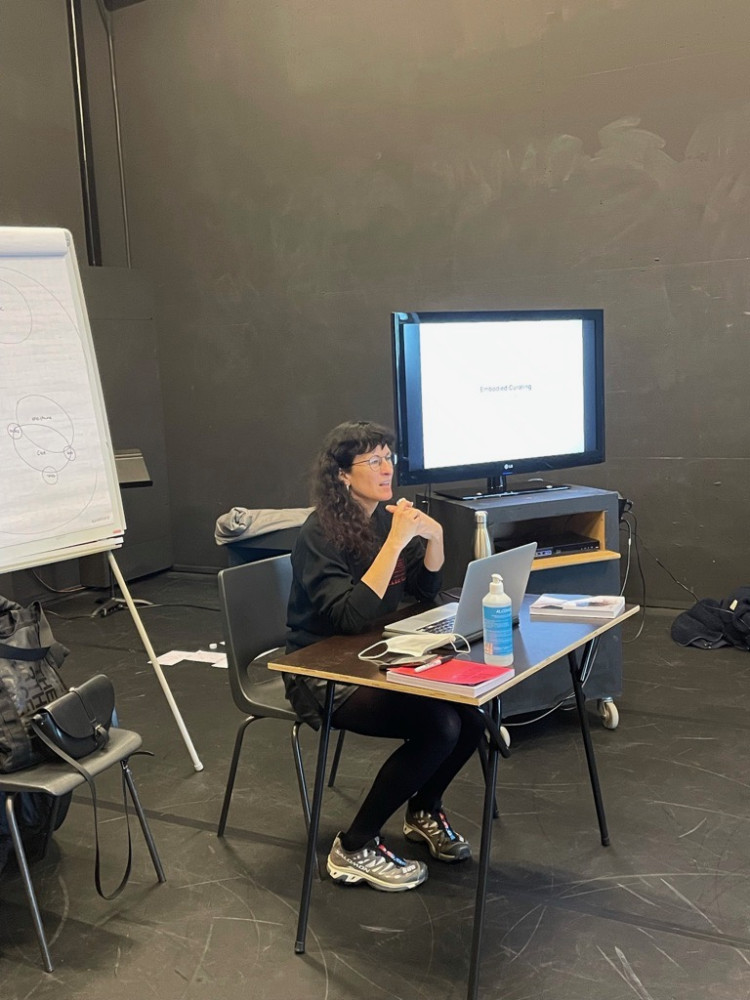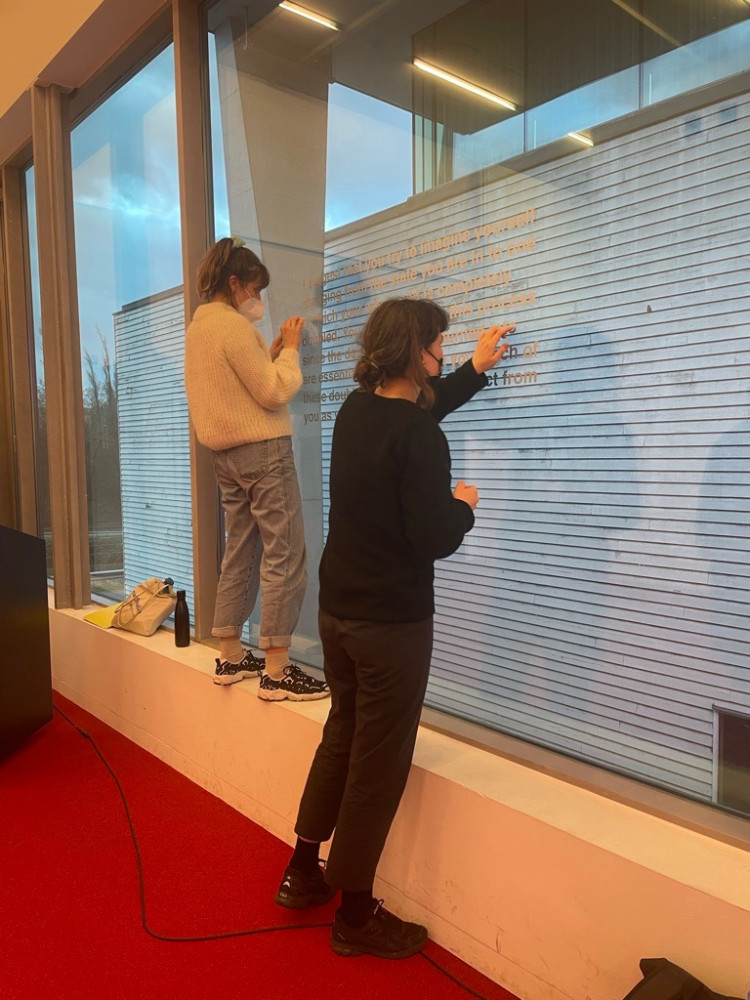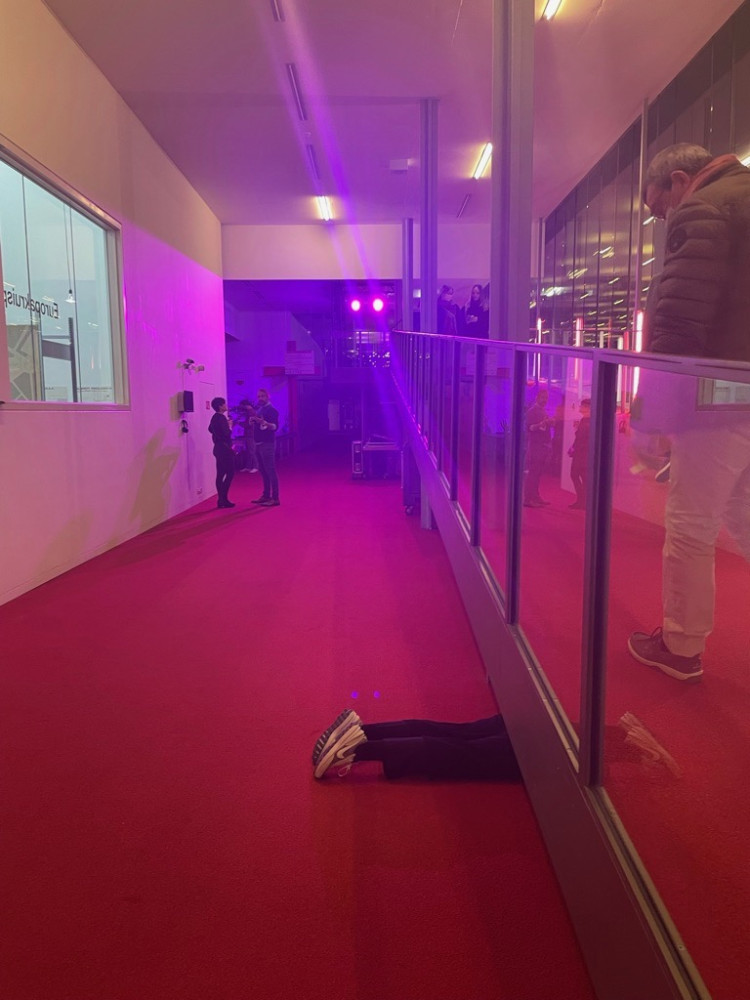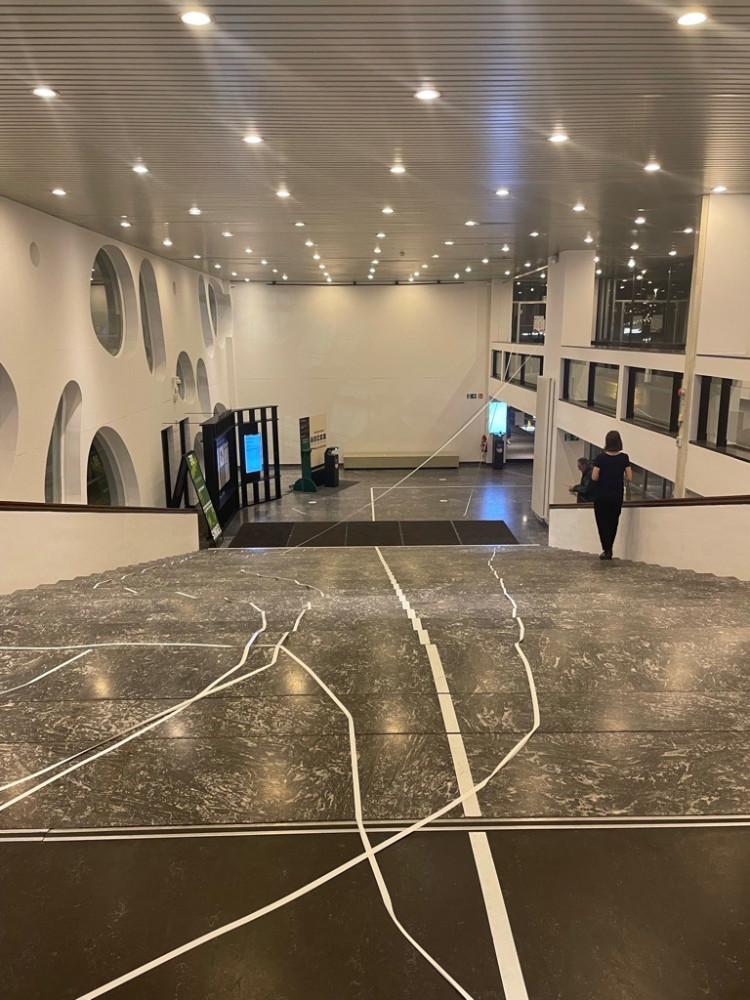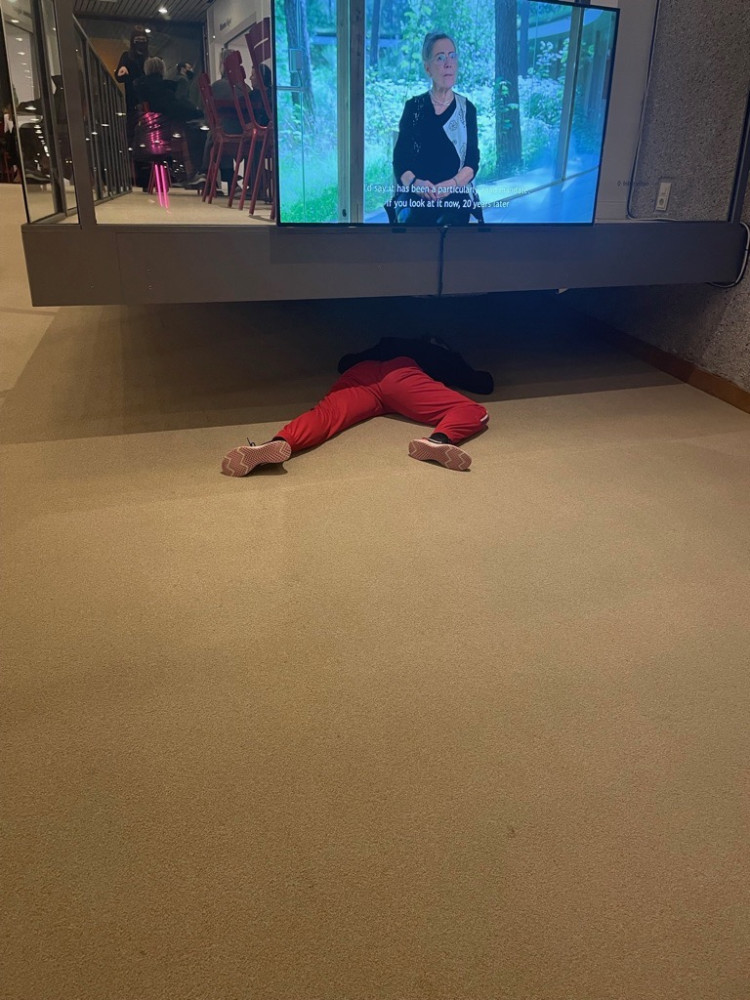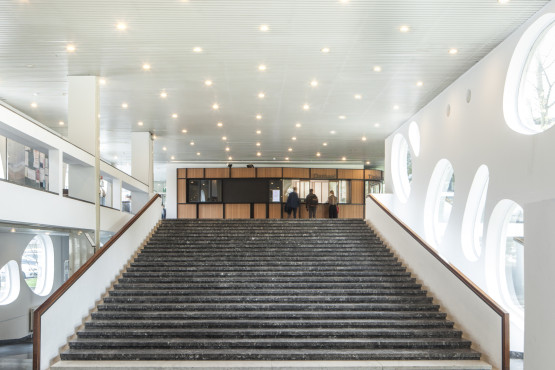
Masterclass: Embodied Curating
KCA Master Dance & Curatorial Studies
14–18.02.2022
DeSingel
Live performance gains more and more terrain with the visual arts world. Although during the twentieth century there have been many moments of live arts within visual arts contexts, it’s only since the 2000’s that its influence became widespread and structural within established visual arts institutions. How do live arts influence museums’ modes of operation? And how does the context of the museum offer new possibilities for the development of live arts? During a one-week exchange between the residents of the Master Dance and the curators-in-development of Curatorial Studies, the participants delve into the history of curation and live arts, different points of view and curatorial practices are examined, and the participants take the modernist building of Arts Centre deSingel as a playground to organise a live art exhibition.
During this exchange week between the Master Dance and Curatorial Studies we will focus on the crossroads between live arts and the curatorial. How to create curatorial frames for live arts? How different is the economy of live arts in relation to curating objects? How do live arts respond to the attention economy? These and more questions form the base of this week.
Participants will have a two-folded schedule. On the one hand, there are lectures/exchange/input moments with invited guests (Michiel Vandevelde, Raimundas Malasaukas, Kopano Maroga, Dorothea von Hantelmann, Ula Sickle). On the other hand, the participants develop collaborative work. In smaller groups, the Master Dance students and the Curatorial Studies participants create together a curatorial concept in relation to a performative intervention within the building of deSingel.
Radiant Nights
The result of these collaborations is presented during the first evening of the Radiant Nights platform at deSingel.
Biographies
Michiel Vandevelde
Michiel Vandevelde studied dance and choreography at P.A.R.T.S., Brussels. He is active as a choreographer, curator, writer and editor. As a curator he worked or works for: Extra City Kunsthal, Het Bos, Bâtard festival, Precarious Pavilions, Arts Centre DeSingel. He is involved as an editor in the Disagree. magazine, and he has written articles for Etcetera, De Witte Raaf, Rekto:Verso, H ART, Mister Motley, etc. From 2017 to 2021 Michiel Vandevelde is an artist in residence at Kaaitheater (Brussels, BE). In his work, he investigates the elements that constitute or obstruct the contemporary public sphere. He explores which other social, economic and cultural alternatives we can imagine to question, challenge and transform dominant logics and ways of organizing. He has been developing various projects both in public space and in (performing) arts institutions.
Raimundas Malasauskas
Raimundas Malašauskas is a Lithuanian curator and writer living in Brussels. His curatorial and writing practices are notable for their questioning approach to the exhibition concept, creating unpredictable, often playful results. Raimundas was curator of the CAC Vilnius from 1995 – 2006, and Artists Space, New York from 2007 – 09. He recently curated Meeting Points 8, Cairo/Brussels/Beirut, 2017, part of the Liverpool Biennial 2016; The Lithuania and Cyprus Pavilion at the Venice Biennale 2013; and Repetition Island at the Centre Pompidou, and Satellite 4 at the Jeu de Paume, both Paris, 2010. Paper Exhibition – Selected Writings was published by Sternberg Press in 2012, and his notebook on Burlesque was published as part of dOCUMENTA 13. In 2019 he was a visiting Professor to HEAD, Geneva.
Kopano Maroga
Kopano Maroga is a performance artist, writer, cultural worker and co-founding director of the independent dance, movement and embodied politics organization ANY BODY ZINE (anybodyzine.org.za). They are a Master of Arts candidate in Live Art, Interdisciplinary and Public Art through the Institute of Creative Arts at the University of Cape Town. Their interests lie at the intersection of art, social justice and healing knowledge systems. Their current research is in the potential of disidentification and biomythography as tools for destabilizing rigid identity theory. They very much believe in the power of love as weapon of mass construction. Since May 2019 they work fulltime as dramaturge at Art Center Vooruit in Ghent.
Dorothea von Hantelmann
Dorothea von Hantelmann is Professor of Art and Society at Bard College Berlin, art historian, writer, and freelance curator. After her university studies in Berlin and a job as a researcher at the Museum of Modern Art in New York, in 1999 she became a member of the collaborative research project ‘Cultures of the Performative’ which is based at Berlin’s Freie Universität. As part of this project, von Hantelmann has worked intensively on the meaning of ‘performativity’ for visual art and, consequently, also on concepts of participation, critique, and politics. She has published multiple articles on individual artists such as Daniel Buren, James Coleman, Jeff Koons, and Pierre Huyghe and completed a PhD dissertation with the title “How to Do Things with Art: On the Meaning of Performativity for Visual Art”.
Besides her theoretical work, Dorothea von Hantelmann has curated and co-curated several projects and exhibitions, such as ‘Elective Affinities’, an interdisciplinary art/theatre project for the Vienna Festival in 1999 (together with Hortensia Völckers and others), ‘I like theatre & theatre likes me’ for the Deutsches Schauspielhaus in Hamburg in 2001, and ‘I promise it’s political’ for the Museum Ludwig in Cologne in 2002. SELECTED PUBLICATIONS: „I promise it’s performative“ (in: Tanja Schwan: Medien, Avantgarde, Performativität, 2005), „How to Do Things with Art“ (in: Fischer-Lichte, Risi, Roselt: Kunst der Aufführung, Aufführung der Kunst, 2004), „Production of Space - Space of Production“ (in: Elmgreen & Dragset: Spaced Out, 2002), „Showing Art Performing Politics“ (in: Jongbloed, von Hantelmann: I promise it’s political, Museum Ludwig Köln, 2002), „art moving politics“ (in: Stepken, Badischer Kunstverein: Lesebuch, 2001).
Ula Sickle
Ula Sickle (CA/PL) is a choreographer and performer based in Brussels, Belgium. From a background in contemporary dance, she works across disciplines, drawing from the visual arts or contemporary music. While her work takes many forms, she focuses on a choreographic approach to movement and a work on perception and reception, specific to the live arts.Her interest in looking for an alternative to the cannon of contemporary dance, has led her to seek out performers who embody other movement histories. Frequently centered around strong performers, she searches for forms of choreographic writing, where the cultural coding and political power of ‘popular’ dancing can be revealed or where the musicality and materiality of the body itself can take center stage.
Ula studied Art History & Semiotics at the University of Toronto and Performance Studies at Paris VIII, before attending P.A.R.T.S. Performing Arts Research and Training Studios in Brussels. From 2008-2010 she pursued her interest in film, studying at Le Fresnoy, a post-graduate media program in the North of France. In 2017 she was artist in residence at the Ujazdowski Castle, Center for Contemporary Art in Warsaw and in 2018 she was artist in residence at Wiels in Brussels. She is currently a PhD researcher at KU Leuven University and Luca School of Arts in Brussels
Yann Chateigné Tytelman
Yann Chateigné Tytelman is a curator and writer based in Brussels. His interests span from minor histories and counterculture, sciences of the mind to the politics of obscurity. He is currently exploring how an exhibition can take the form of a novel, while researching the subject of the disappearance of the Night. Often working in cooperation, his projects navigate the intersections of curating, publishing, performance and education. In 2021—22, he will be the guest curator of Country SALTS, a new space operating in the countryside near Basel. Connecting art and rural ways of life. He recently acted as the artistic mentor of the Fall/Winter Session at MORPHO artists residency in Antwerp. Since 2018, he also serves as PhD Supervisor at the Royal Academy of the Arts in Oslo. In recent years, he (co)curated “Gordon Matta-Clark: Material Thinking” (Canadian Center for Architecture, Montréal, Museum der Moderne, Salzburg, 2019—2022), “It Never Ends” (KANAL – Centre Pompidou, Brussels, 2020 – 21) and “By repetition, you start noticing details in the landscape” (Le Commun, Genève, 2019 – 2020). In parallel, YCT edited collective publications, artists books and monographs including “Curating in the educational field” (HEAD – Genève/Les Presses du Réel, 2019), “Joachim Koester. Bringing something back” (Bergen Kunsthal/Koenig Books, 2019), and “Almanach Ecart. A collective archive, 1969 – 2019” (HEAD – Genève/art&fiction, 2019 – 21), awarded the Golden Letter, the highest award of the 2020 edition of the Best Book Design From All Over the World. YCT previously held the positions of Chief curator at CAPC Museum of Contemporary Art in Bordeaux (2007 – 09) and Head of the Visual Arts Department at Geneva School of Art and Design (2009 – 17). As an independent critic, he contributed to several books, catalogues and periodicals including Mousse, Spike and Frieze. He taught at various schools and universities, including Ecole du Louvre, Paris, HEAD – Genève and Erg, Brussels.
43521
Parallel Programme to Radiant Nights #3
18.02.2022
19:00-23:30
DeSingel International Art Center
A proposal by Josue Alejandro Aliendre, Myrna D'Ambrosio, Natalia Barczyńska, Valentina Bianchi, Isabella Daffara, Raphael Damasceno, Minne De Meyer Engelbeen, Rebecca Fokkema, Amanda Hakoköngäs, Luisa Heilbron Valeriano, Arno Huygens, Anna Laganovska, Cyriel Lucas, Marcos Martincano, Jenneke Slaets, Fyllenia Grigoriou, Yasaman Tamizkar, Alexandra Tryanova, Cristina Valdivielso Garcia, Adriënne van der Werf, Bas Verwaetermeulen and Libby Ward
Developed in the context Embodied Curating, a masterclass and exchange week between the residents of the Master Dance at Koninklijk Conservatorium & deSingel, Antwerp and the participants of the Curatorial Studies programme at KASK, Gent, on the occasion of the festival Radiant Nights #3.
In this place, which used to be a vast institutional complex, a show was supposed to be presented. In the end, it seems that it never did. Instead, for some reason, the artists decided that they would arrange a series of almost silent actions, that interacted with the visitors of what was, back then, an impressive building, symbolizing the greatness of culture and the power of this community. It was a sort of gigantic vessel, whose imposing geometry imbricated theater rooms and concert halls, a gallery, a garden and several offices, some restaurants and an educational aisle. Like a constellation of discreet, or even quasi-imperceptible interventions, the performances occupied the periphery of the spaces that, as you can see, are now totally abandoned. It seems that they reflected an attempt to connect isolated entities, subjects, and things, and in the meantime to reveal invisible borders, to generate forms of relations while affirming a distant critique, a withdrawal of some sort.
You have to imagine what the situation was at the time. Within a very few years, a massive ecological disaster destroyed, in waves, most of the foundations on which relied the organization of this society. It started by creating contradictory social movements, hopes, and revolt, and then a form of progressive and deep, yet unnoticed at first normalization, accompanied by floods of control, and fear. it collided finally into a chaotic and global polarization of all groups. A very few things seem to still have a meaning, and they were difficult to find. Artists had to navigate a dual reality, brutal and mediated by technologies on one hand; liquid, uncertain and based on what they, ironically or not, called “bubbles”, would it be individual, corporal or psychic, social, political, or institutional. To understand what was at stake here, I guess then, you might try to travel back in time. Please follow me.
From the very moment the visitor entered the building, passing through these then transparent doors, movement within the space unfolded as if led by a scripted choreography: from the stairs, to the cloakroom towards the theater venue, with pit stops to the toilet and a quick drink at the bar, they were offered A way around. A linear and paced journey reinforced even more by safe protocols, where floor arrows and social distancing signs further dictated the tempo of the night. By introducing subtle but surprising interventions into the existing infrastructure, the artists subverted and challenged the automation of human action. The visitor’s expected and linear way of navigating the space was disrupted, and in doing so the performers nuanced this state of confusion, anticipation, and change of speed. It has been interpreted as if by offering moments of playful interaction, the performers seduced the visitors and invited them to let go, to free themselves from conditioned actions, and perhaps let the joy of something unexpected take over and lead the way.
The experience of discontinuity is a driving force for erotic desire. On that window, near the center of this area, a textual fragment of writer and philosopher Georges Bataille (1897 – 1962), connected further to the notion of the uncanny as experienced when encountering a double, which similarly links to the experience of death from a psychoanalytic perspective. This disguised inclusion invited the visitors to imagine themselves in a state in which one’s whole self is completely doubled, which would imply seizing to exist as one is, embodying the alienated human state of discontinuation. Meanwhile, during the evening, it appeared that a performer would pick out unsuspecting visitors and begin actively mirroring their movements, embodying them until the performer was noticed. We have been deducing that when a connection was established, the performer stopped mirroring, handed the visitor a small card with an ambiguous, appropriated text linked to the notion of double, and walked away, leaving the visitor bewildered. One question remains unanswered, lying in the interrogation on the meaning of the sentence, used by the artists to sign off their proposal: We both like Italian furniture.
What if curiosity brings us to new places? While walking through these oversized hallways that connect the different zones of the site like distant islands, visitors might have not noticed a series of still bodies occupying spaces within the building, forgotten, alienated. These non-spaces are leftovers, monstrous portions of a seemingly rational construction. The minimal actions by the artists pointed at these unseen locations, that suddenly became the semi-hidden stages where bodies would appear, haunt, and suggest a different purpose. The aim of the artists seems to have been to “unlearn the usual use of architecture”. These not-yet-investigated spaces became the subject of an attention to phantom-places, calling for unconventional bodily ways, altering the surroundings, and raising the curiosity for a becoming-unknown building.
A rumor circulated that visitors were at some point lured to a place called The Drought. Described by some as something like a shell after the flesh is gone – creating unrequitable expectations from the beginning, it was using an empty foyer, where fresh and less fresh reminders were left, suggesting that somebody could have been present at any moment. But there, the visitor perpetually waited to be served. The only spoken word were pronounced by two actors, engaging in a discussion on zombified spaces, lifted from the pages of novelist J.G. Ballard’s Drought – referencing both artist Dominique Gonzalez-Foerster’s Ballard Garden (a permanent sculptural work inaugurated in 2014, and that already stood as a ruin from a future located in the past), and the lost natural surroundings of the campus. In this space, perhaps, some audience members once met each other. There, the pre-and-post performing arts conversations seem to still float in the air like a perfume once forgotten: words, smiles, bar-noises resonate through time.
As we are now walking together in this space again, lost and found again at a distance of more than 2000 years, like the moraine that brings up to the surface the remains lying in the deep strata of memory, I have to confess something. I think I heard something. First I thought it was a sound hallucination. It reminded me of the words once sung by late 20th Century composer John Cale. It went like this, it came from some moment of one of his famous songs or at least, this is how I am remembering it now: “You're a ghost. la la la la la la la la la... You're a ghost. la la la la la la la la la...”. Did anyone hear it? Am I the only one? Please, don’t tell me I am the only one… Please throw your ears there again and tell me that you’re hearing it as well…!
